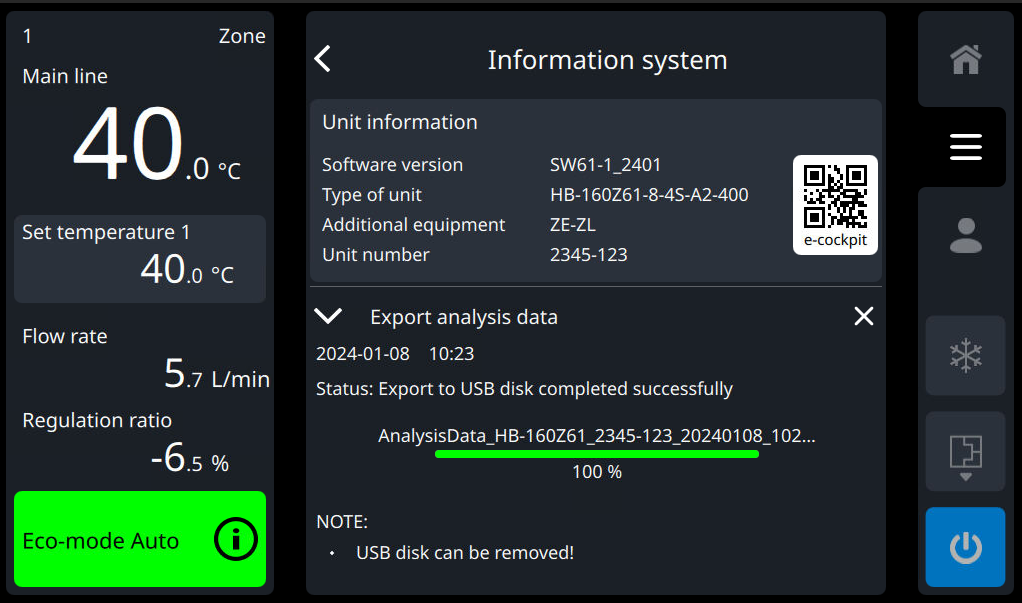Download PDF
Download page Unit data.
Unit data
Various data can be stored on a USB data carrier or imported from a USB data carrier to the unit's control system. With this function, data can be transferred from one unit to another. In the event of a fault, analysis data can be read out on a USB data carrier for fault diagnosis and sent to your HB-Therm distributor (www.hb-therm.com). The analysis data can also be delivered via the e-cockpit app with the “sending analysis data” function (→ e-cockpit functions).
NOTE!
- USB data carriers formatted with FAT, FAT32, exFAT and ext2/3/4 are supported.
- A connected and recognized USB data carrier is displayed on the basic screen with the data carrier symbol (
 ).
). - During data transfer, the disk symbol (
 ) on the basic screen flashes yellow.
) on the basic screen flashes yellow. - When saving the parameterdata, the set user profile is saved.
Save and load data

Close the USB drive.
- On the home basic screen, tap the main menu button (
 ).
). Select [Save/Load].
Select the data you want to back up or the data you want to load.
Tap the disk symbol (
 ,
,  ) to start the process.
) to start the process.
→ The Explorer window from the USB drive appears on the screen.Select the desired directory.
→ The data is written to the USB data carrier as a CSV file. The information system is opened automatically and the current progress is displayed (→ Fig.).
→ When charging, the data is transferred to the unit's control system. If the transferred values are outside the allowed range, they are reset to the default value.
Name of data
The file names on the USB drive are created automatically according to the following examples. The date and time information corresponds to the time of export. A suffix [n] is automatically added if the file name already exists.
Analysis data
The analysis data contains all information relevant to customer service that is required for targeted failure analysis. In the event of an error, it is recommended to save the analysis data and send it to customer service.
Directory folder:
AnalysisData_<UnitBasicType>_<Serialnumber>_<YYYYMMDD>_<HHMMSS.zip
Example → AnalysisData_HB-160Z61_1234-567_20230621_161301.zip
Content:
Historical data (device data recording from the current day and from the previous day)
- Operating data
- parameterdata
- configurationdata
- alarm logbook
- User logbook
USR-61 system log file
GAT-61 system log file (if a Gate-6 is connected)
Operating data
The operating data contains information that is collected during operation, such as the number of operating hours.
BD_<UnitType>_<Serialnumber>_<YYYYMMDD>_<HHMMSS.csv
Example → BD_HB-100Z61-8-4T-A2-400_1234-567_20230621_161301.csv
Content:
- operating hours
- Software/hardware information
- Maintenance progress
- Number of functions executed
Number of circuits (valves, relay)
parameterdata
The parameterdata contains general settings for their various functions. Through export and import, this data can be saved and transferred to another unit, e.g. Application-specific values (set value, temperature/flow tolerances).
NOTE!
Only the parameter that belong to the current user profile are exported (→ Menu structure).
Par_<UnitBasicType>_<YYYYMMDD>_<HHMMSS>.csv
Example → Par_HB-100Z61_20231118_161414.csv
Content:
parameter ID
Parameter name
parameterdata including unit (e.g. °C, K/min)
configurationdata
The configurationdata includes the unit's specific settings. Through export and import, this data can be saved and transferred to another unit, for example when replacing a unit board.
Conf_<UnitType>_<YYYYMMDD>_<HHMMSS>.csv
Example → Conf_HB-100Z61-8-4T-A2-400_20211118_161414.csv
Content:
- unit configuration
alarm logbook
The alarm logbook can be viewed in the main menu under the “alarm logbook” tile. The last 100 alarm messages that occurred are listed chronologically.
Al_<UnitBasicType>_<Serialnumber>_<YYYYMMDD>_<HHMMSS>.csv
Example → Al_HB-160Z61_1111-777_20210419_084301.csv
Content:
last 100 fault reports that occurred
User logbook
The user logbook can be viewed in the main menu under the “User Logbook” tile. There, the last 200 user interactions carried out are listed chronologically.
- UI_<UnitBasicType>_<YYYYMMDD_HHMMSS>.csv
Example → UI_HB-160Z61_20230318_104235.csv
Content:
last 200 user interactions performed